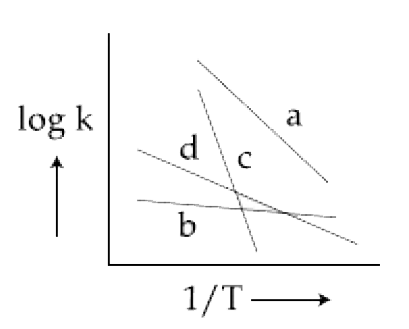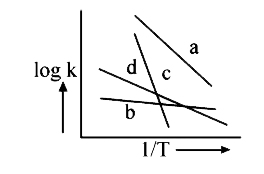For the D−T fusion reaction, find the rate at which deuterium & trithium are consumed to produce 1MW. The Q-value of D−T reactions is 17.6MeV & assume all the energy from the fusion rection is available.
The correct Answer is:2NA×117.6e×10−3Kg/s=1.179×10−9kg/s
3NA×117.6e×10−3kg/s=1.769×10−9kg/s
Each deiterium nucleus prodeuces 17.6MeV.
1kg of deuterium =1×1032NA no. of deuterium ≡17.6×1032NAMeV energy produced.
∴ To produce 1MW, amount of deuterium in kg required per second.
=1×10617.6×1032×NA×e×106kg/s=17.69×10−9kg/s
Topper's Solved these Questions
- NUCLEAR PHYSICSBOOK - RESONANCECHAPTER - NUCLEAR PHYSICSEXERCISE - Exercise-1 Part-2 Only one option correct type
27 Videos
- NUCLEAR PHYSICSBOOK - RESONANCECHAPTER - NUCLEAR PHYSICSEXERCISE - Exercise 2 Part-1 Only one option correct type
20 Videos
- NUCLEAR PHYSICSBOOK - RESONANCECHAPTER - NUCLEAR PHYSICSEXERCISE - Advanced level solutions
16 Videos
- GRAVITATIONBOOK - RESONANCECHAPTER - GRAVITATIONEXERCISE - HIGH LEVEL PROBLEMS
16 Videos
- REVISION DPPBOOK - RESONANCECHAPTER - REVISION DPPEXERCISE - All Questions
444 Videos
Similar Questions
A fusion reaction of the type given below
.21D+.21D→.31T+.11p+ΔE
is most promissing for the production of power. Here D and T stand for deuterium and tritium, respectively. Calculate the mass of deuterium required per day for a power output of 109W. Assume the efficiency of the process to be 50%.
Given : m(.21D)=2.01458amu, m(.31T)=3.01605amu
m(.11p)=1.00728amu and 1amu=930MeV.
View SolutionThe deuterium-tritium fusion reaction (called the D-T reaction) is most likely to be the basic fusion reaction in a future thermonuclear fusion reactor is
.21H+.31H→.42He+.10n+Q
(a) Calculate the amount energy released in the reaction, given m(.21H)=0.014102 amu. m(−(1)3H)=3.016090 amu, m(.1n0=1.008665 amu and m(.42He)=4.002603 amu.
(b) Find the kinetic energy needed to overcome coulumb repulsion. Assume the radius of both deterium and tritium to he approximately 1.5×10−15m.
(c) To what temperature must the gases be heated to initiate the fusion reaction? Take Boltzmann constant k=1.38×10−23JK−1.
View Solution
Knowledge Check
Which equation is true to calculate the energy of ativation, if the rate of reaction is doubled by increasing temperature from T1KtoT2K?
Alog10(k1k2)=Ea2.303R[1T1−1T2]Blog10(k2k1)=Ea2.303R[1T2−1T1]Clog10.12=Ea2.303R[1T2−1T1]Dlog10.2=Ea2.303R[1T1−1T2]Consider the following plots of rate constant versus 1T for four different reactions. Which of the following orders is correct for the activation energies of these reactions ?
 AEc>Ea>Ed>EbBEb>Ea>Ed>EcCEa>Ec>Ed>EbDEb>Ed>Ec>Ea
AEc>Ea>Ed>EbBEb>Ea>Ed>EcCEa>Ec>Ed>EbDEb>Ed>Ec>Ea
Consider the D-T reaction (deuterium-tritium fusion)
21H+ 31H→ 42He+n
(a) Calculate the energy released in MeV in this reaction from the data: m( 21H)=2.014102u,m( 31H)=3.016049u
(b) Consider the radius of both deuterium and tritium to be approximately 2.0 fm. What is the kinetic energy needed to overcome the coulomb repulsion between the two nuclei ? To what temperature must the gas be heated to initiate the reaction ? (Hint: Kinetic energy required for one fusion event = average thermal kinetic energy available with the interacting particles = 2(3kT/2), k = Boltzman’s constant, T = absolute temperature.)
View SolutionFor a reaction , 2A+D→3C, the rate of appearance of C at time t is 1.2×10−4mol L−1s−1 . Find the rate of reaction.
View SolutionIn the fusion reaction _12H+21H→32He+10n, the masses of deuteron, helium and neutron expressed in amu are 2.015, 3.017 and 1.009 respectively. If 1 kg of deuterium undergoes complete fusion, find the amount of total energy released. 1 amu =931.5MeV/c2.
View SolutionConsider the following plots of rate constant versus 1T for four different reactions. Which of the following orders is correct for the activation energies of these reactions ?

View SolutionA nucleus with mass number 220 initially at rest emits an α-particle. If the Q-value of the reaction is 5.5 MeV, calculate the kinetic energy of the α-particle.
(a) 4.4 MeV (b) 5.4 MeV (c) 5.6 MeV (d) 6.5 MeV
View SolutionConsider the following plots of rate constant versus 1T for four different reactions. Which of the following orders is correct for the activation energies of these reactions?

View Solution